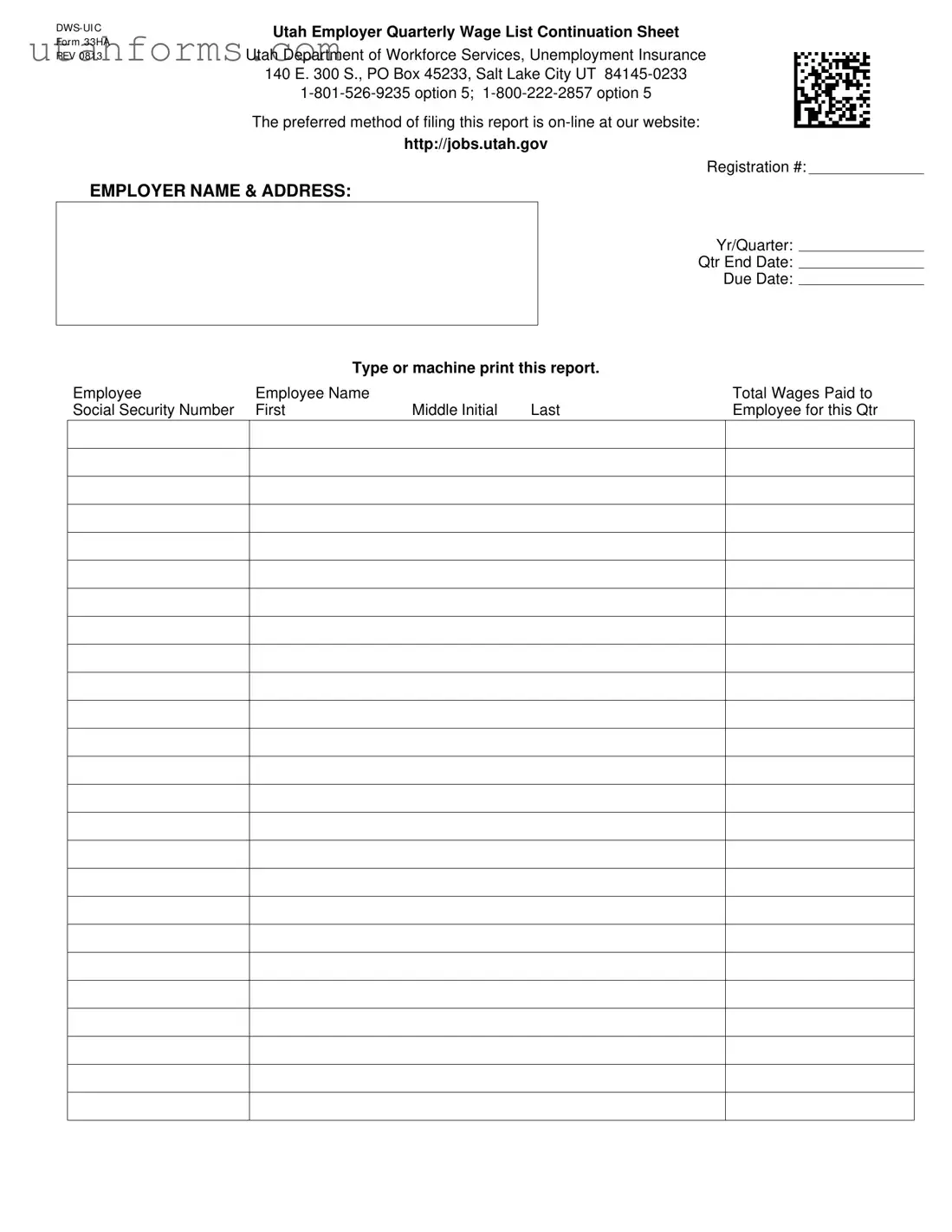The Federal Unemployment Tax Act (FUTA) Tax Return closely resembles the Jobs Utah Gov form in several ways. Both documents are essential for employers, as they detail the wages paid to employees within a specific period. FUTA forms are used at the federal level to report quarterly wages and calculate unemployment tax owed to the IRS. Similarly, the Jobs Utah Gov form serves to report employee earnings to the Utah Department of Workforce Services for unemployment insurance purposes. Each form collects employer information, including the total wages paid to each employee during the quarter.
The Quarterly Federal Tax Return, also known as Form 941, is another document sharing similarities with the Jobs Utah Gov form. Form 941 is used by employers to report income taxes, Social Security tax, or Medicare tax withheld from employees' paychecks. Additionally, it reports the employer's portion of Social Security or Medicare tax. Like the Jobs Utah Gov form, it is filed quarterly and requires detailed employee wage information, underscoring the documentation's integral role in tax and wage reporting.
State New Hire Reporting forms, which vary by state, also mirror the Jobs Utah Gov form in their function. These forms require employers to report new employees to a designated state agency shortly after hire, including employee names, addresses, and Social Security numbers, much like the wage list continuation sheet requires for unemployment insurance purposes. The main goal of both documents is to ensure compliance with employment regulations, though they serve different ends—unemployment insurance and child support enforcement.
Workers' Compensation First Report of Injury forms are submitted by employers following a workplace injury or illness. While focusing on incidents rather than quarterly wages, this form similarly collects detailed employee information, such as name and Social Security number, internalizing the importance of accurate record-keeping in both cases. The rationale behind both is to provide necessary benefits—unemployment or workers' compensation—to eligible employees.
The Employer's Quarterly Contribution and Wage Report, specific to state workforce agencies, shares a direct purpose with the Jobs Utah Gov form. It's designed to report wages paid, taxes owed, and contribute to the state's unemployment insurance fund. Both forms are crucial for maintaining the integrity of unemployment insurance programs, ensuring that benefits are available for individuals who may become unemployed.
The W-2 Form is annually filed and details the wages paid and taxes withheld for each employee. While it covers a year rather than a quarter and serves a slightly different purpose—informing employees about their annual earnings for their tax returns—it parallels the Jobs Utah Gov form in its emphasis on detailed employee wage reporting. Both documents play critical roles in the broader context of tax and income reporting.
The I-9 Employment Eligibility Verification form is distinctly different in its primary purpose—verifying an employee's legal authorization to work in the United States. However, like the Jobs Utah Gov form, the I-9 becomes a part of the employment compliance requirements, ensuring that all employees are documented and legally permitted to work, indirectly contributing to accurate and lawful wage reporting.
Payroll Processing forms, used by companies to manage and record employee wages, echo the utility of the Jobs Utah Gov form by tracking employee earnings and deductions extensively. Although these payroll documents are internal and vary by company, their meticulous collection of wage data supports the accurate completion of official documentation like the Jobs Utah Gov form, which relies on comprehensive payroll information for its filings.
The Business License Application forms, while generally focused on obtaining permission to operate a business within a certain jurisdiction, occasionally require information about employees for demographic or regulatory reasons, depending on the locale. This indirect collection of employee data shows a broader regulatory environment where businesses must regularly report detailed employment information, akin to the reporting on the Jobs Utah Gov form.
Finally, the Occupational Safety and Health Administration (OSHA) reporting forms, essential for documenting workplace illnesses and injuries, demand meticulous record-keeping about employees, similar to the Jobs Utah Gov form. Although they serve health and safety compliance rather than unemployment insurance, the premise of protecting employee welfare underscores the importance of accurate employee data collection in both instances.

